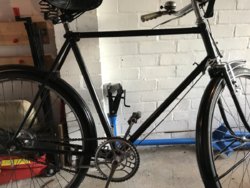olliewally87
New Member
Hi,
I am new to this forum, so first of all hello!
I’ve got a question regarding rod brakes - I’ve been trying to get the rear rod brake on my 1952 Triumph working. To me, the rod underneath the down tube appears too long - could this be the case? I got the bike from a jumble and It wasn’t working at the time so I wonder if I’ve got the wrong part. Anyone got much experience with rod brakes that could offer some advice? I’ve attached a photo for reference!
Thanks in advance.
Ollie
I am new to this forum, so first of all hello!
I’ve got a question regarding rod brakes - I’ve been trying to get the rear rod brake on my 1952 Triumph working. To me, the rod underneath the down tube appears too long - could this be the case? I got the bike from a jumble and It wasn’t working at the time so I wonder if I’ve got the wrong part. Anyone got much experience with rod brakes that could offer some advice? I’ve attached a photo for reference!
Thanks in advance.
Ollie

